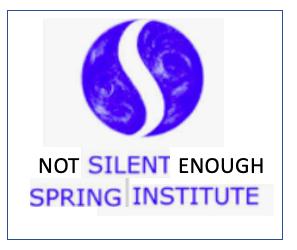In the mood for some hilarity? I am.
A new press release from the Silent Spring Institute (SSI) makes me wonder whether they've jumped the gun on April Fool's Day. Don't believe me?
"Consumers who avoid products with harmful chemicals on the label have lower body burden."
I'll go into the "details" later but let's cut to the summary: People who avoid certain chemicals have less of those chemicals in their bodies. Duh?
Isn't that a bit like saying:
"People who swing an ax at their forehead are more likely to have an ax embedded in their foreheads than people who do not swing an ax at their forehead."
Although the organization commissioned a study (1) that essentially proved that circles are round, what's behind this silliness is worth discussing: Endrocrine disruptors, the poster children of junk science.
These chemicals, which supposedly screw up your hormones, are the bread and butter of groups like the Environmental Working Group (EWG) and the Natural Resources Defense Council (NRDC) – very well-funded environmental groups that should stick to environmental issues (2). This much becomes obvious when you look at the leadership of these places – a bunch of lawyers and political science majors. You'd think that with all that money they might be able to find a living chemist or two.
It would seem not. NRDC produced a gag-provoking video that equated chlorpyrifos (a widely used insecticide) with Nazi nerve gas weapons. I cheerfully shredded this nonsense in 2018 (See NRDC's Hitler-Pesticide Video Worthy Of Joseph Goebbels). You'll have to read my article to get a glimpse of how ridiculous the video is, but suffice it to say that when it was time for an opinion about chemistry, guess who NRDC used as their "chemical expert"?
Forget it. You'll never guess.
It was New York Times columnist Nicholas Kristoff, a fine man (and writer) but a complete nincompoop when it comes to chemistry. Kristoff is so afraid of chemicals that he won't touch cash register receipts because they contain a little bisphenol A (BPA) on the paper (See Why I Don't Write About Pottery From The Ming Dynasty And Nick Kristoff Shouldn't Write About Science). More on BPA later.
"In a study led by Silent Spring Institute, researchers found that consumers who avoided products containing specific endocrine disruptors had significantly lower levels of the chemicals in their bodies."
I could not agree more – it's the ax in the forehead thing again. But there's also a common but insidious trick in this sentence, one that anti-chemical groups use ad nauseam; equating the presence of a chemical with harm from that chemical. It's a bunch of nonsense because phony chemical scare articles almost always avoid mentioning the dose (exposure). Without this information, it is impossible to determine real harm. But that doesn't stop SSI from trying.
The study is sort of a joke. A bunch of people (726) signed up for a "crowdsourced biomonitoring project," which involved sending in urine samples which were tested for 10 suspected endocrine disruptors. Then the participants completed an online survey about which products they use and whether they avoid ones with specific chemicals listed on the label. Here are the results;
1. A dead horse was re-beaten: People who avoided certain chemicals had fewer chemicals in their urine. Blah blah...
2. But not always. There was one exception - people who tried to avoid products containing BPA had just as much BPA in their urine as those who didn't. Why? Because BPA is ubiquitous. It is used to make beverage containers and to provide a safe seal in can liners so just about everyone in the US has some of it in their urine (3,4). Does this make it harmful? Nope. In fact, evidence shows the opposite (5,6).
BPA is one of the most studied chemicals in the galaxy. Academics have based their entire careers on trying to find something wrong with it and have made some absurd claims. But despite numerous studies supporting the safety of the chemical, the FDA nonetheless conducted the exhaustive two-year CLARITY-BPA study in rats. The conclusion:
"After considering these data, the levels of exposure, and the extent of metabolic inactivation of BPA upon ingestion, most international regulatory agencies have concluded that current nonoccupational BPA exposures do not pose a credible risk to humans."
I've written many articles about BPA. I recommend "BPA Is Just As Dangerous As It Never Was". It is especially obnoxious.
There is plenty more wrong with the study, but it's time to quit – almost. I can't let this go by:
"With the current pandemic, we see how diseases associated with environmental chemicals also make people more vulnerable to COVID-19--yet another reason to reduce exposures in the population."
Dr. Robin Dodson, environmental exposure scientist
It is disgraceful and exploitive to claim that trace chemicals have any impact on COVID-19. There is zero evidence to back this up.
Let's finish up with a little fun. Silent Spring is so afraid of chemicals that they even developed an app to help you avoid chemicals. Check it out. Anything wrong with this picture?

Hmmm... Photo: SSI website


Look at her arm. She's trying to avoid trace quantities of mostly harmless chemicals with an app despite having a whole bunch of not-so-harmless chemicals injected into her skin. Sort of like worrying about radiation from your microwave oven while vacationing in the ruins of Chernobyl. That app is going to be as useful as a snowmobile in Egypt. FYI, let's see what Katharine Sanderson writing in Chemical and Engineering News had to say about tattoos:
"Tattoo inks contain a wide range of chemicals and heavy metals, including some that are potentially toxic. Because of concerns about this potential toxicity, last year, the Joint Research Centre, which provides advice to the European Commission, issued a report highlighting the need for funding into research on tattoo ink toxicity and how tattoo inks break down in the body."
Chemical and Engineering News, 9/25/17
Once more, we have a bunch of activists making a whole lot of noise about nothing. Wouldn't it be better if they were silent? Maybe someone should read them the Miranda warning.
Rim shot.
NOTES:
(1) Dodson, R.E., K. E. Boronow, H. Susmann, J.O. Udesky, K.M. Rodgers, D. Weller, M. Woudneh, J.G. Brody, R.A. Rudel. 2020. Consumer behavior and exposure to parabens, bisphenols, triclosan, dichlorophenols, and benzophenone-3: Results from a crowdsourced biomonitoring study. International Journal of Hygiene and Environmental Health. DOI: 10.1016/j.ijheh.2020.113624
(2) Ask yourself why environmental groups are dabbling in toxicological/medical matters. What does this have to do with the environment? Is it possible that these groups are heavily funded by the organic food industry, which wants you to believe that you can live a chemical-free life?
(3) Calafat, A.M., X. Ye, L.Y. Wong, J.A. Reidy, and L.L. Needham. 2008. Exposure of the U.S. population to bisphenol A and 4-tertiary-octylphenol: 2003-2004. Environmental Health Perspectives 116 (1):39-44. 8
(4) Why are these chemicals (or, more likely, their metabolites) found in urine? It's because your liver is doing its job – converting chemicals, drugs, etc. into water-soluble derivatives that are then excreted. The concentrations in blood, which might have some physiological significance, were not determined. With some rare exceptions, chemicals do not bioaccumulate; they are processed and eliminated. Just like nature intended.
(5) From the EPA (2018) "EPA does not intend to initiate regulatory action under TSCA at this time on the basis of risks to human health."
(6) Of course, there are still groups and a few agencies that have safety concerns about BPA. No amount of research will ever change this.




